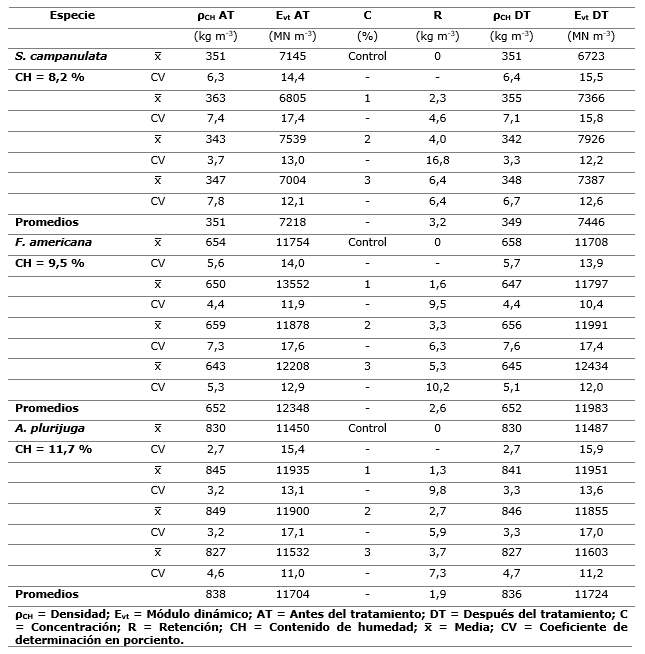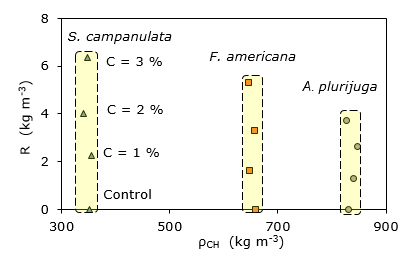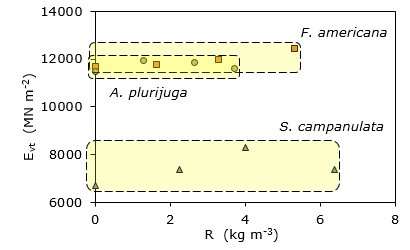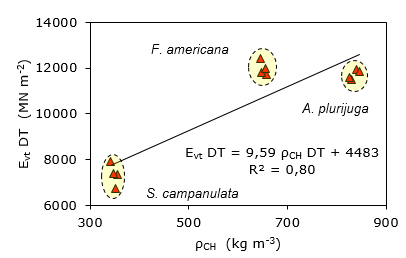My SciELO
Services on Demand
Article
Indicators
-
 Cited by SciELO
Cited by SciELO
Related links
-
 Similars in
SciELO
Similars in
SciELO
Share
Revista Cubana de Ciencias Forestales
On-line version ISSN 2310-3469
Rev cubana ciencias forestales vol.8 no.1 Pinar del Río Jan.-Apr. 2020 Epub Apr 04, 2020
Original article
Density and dynamic modulus of three mexican woods impregnated with boron. Evaluation with transverse vibrations
1Universidad Michoacana de San Nicolás de Hidalgo, México.
The objective of this work was to evaluate the effects of boron salts on the physical-mechanical properties of wood. For this, forty specimens of Spathodea campanulata, Fraxinus americana and Albizia plurijuga were treated using the hot-cold bath method in three groups with concentrations of 1 %, 2 %, 3 %, plus a control group. Before and after the treatment, the densities of the wood, the moisture content, its retentions were calculated and its dynamic modules were determined with transverse vibrations. Retention values increased proportionally to the concentration of boron salts used, but decreased as the densities of each species varied. The treatment in small specimens did not alter the densities of the wood. In contrast, the treatment did modify the dynamic modules determined with transverse vibrations. The paradigm in wood sciences that proposes the characterization of the mechanical behavior of each particular species was confirmed. The experiences were carried out in the Wood Mechanics Laboratory of the Faculty of Engineering in Wood Technology of the Michoacana University of San Nicolás de Hidalgo, in Morelia, Mexico.
Key words: Albizia plurijuga; boron salt retention; Fraxinus americana; hot-cold bath; Spathodea campanulata.
Introduction
The daily use and practical application of wood required its protection against occasioned deterioration by biological and/or physical agents (Cruz, 2010; Simsek et al., 2010). The treatment with boron salts are an efficient practice to protect wood of fungi and insects attack, as well as to diminish deterioration, occasioned by its fire exposition (Tondi et al., 2012; Keskin and Mutlu, 2017). This strategy is considered a tendency inside sustainable chemical technology (Simsek and Baysal, 2015; Pizzi, 2016). However, it is necessary to know the effects of preserved substances in physical and mechanical properties of wood.
Lahtela et al., (2014) report that, generally, preserved substances do not modify the wood elastic properties. However, the authors remark the empirical evidence existing in regard to contradictory results. The differences could be attributed mainly to the studied species, type and preserved concentration used, as well as temperature, pressure and treatment time.
Percin et al., (2015) inform that elastic module of Quercus petraea woods increases or decreases according to type of boron salts used, in arrangement with the intensity and duration of thermic treatment used. On the other hand, Simsek and Baysal (2015) refer, for Fagus orientalis and Pinus sylvestris, the increase of wood density and at the same time the decrease of elastic module according to the species in relation to the quantity of boron salt retention. This parameter varies for each wood. These results confirm the Kartal et al., (2008) observations, Cryptomeria japonica wood and Adanur et al., (2017), for Fagus orientalis wood, which consider that all results are particular to each investigation.
Sotomayor and Villaseñor (2016) and Sotomayor and Ávila (2019), Sotomayor castellanos (2016) determine boron salt retention in concentrations of 1 %, 2 % y 3 %, with hot-cold bath method in different woods. Their results suggest the capacity of studied woods to retain boron salt depends on, mainly, the species and it decreases in relation to its density.
About densities and dynamic modules, Sotomayor and Correa (2016), use effort waves to analyze the boron salts effect with a concentration of 3 %, in Guazuma ulmifolia, Spathodea campanulata and Abies religiosa. The authors conclude that these woods could be impregnated with boron sales with hot-cold bath method without reduction of their physical and mechanic properties. The authors propose that it's necessary to characterize the physic-mechanic behavior of wood with an approach of experimentation of case by case of particular species.
Besides, Sotomayor and Villaseñor (2016), use transverse vibrations to verify the boron sales effects with a concentration of 3 %, in the density and dynamic module of species G. ulmifolia, S. campanulata and A. religiosa. Sotomayor et al., (2018), do the same with the species and referred concentration, but this time with static flexion tests. The authors conclude that each species behaves in different way when it is impregnated with boron sales by hot-cold bath process.
In the referred works it is measured parameters such as concentrations and boron sales retentions, as well as its effects on density and elastic module, the last one determined mainly in static conditions. However, the results don´t show a clear tendency respected to increase or decrease of density and elastic module. The differences among previous investigations state that the results are related to variables and test conditions, particularly to the species and retention of reagents. That´s why these authors propose to characterize the mechanic behavior of wood with approach of experimentation of case by case of a particular species.
The strategy of referred works guides the experimental approach of the present investigation, so it is necessary to count with data statistically representative in order to propose impregnated processes in industrial levels (Gérardin, 2016). The objective of this investigation is to determine in which way the treatment modify density and dynamic module. It is started from hypothesis that impregnated treatment doesn´t modify those parameters. To verify this proposal, it was impregnated testing small clear piece of wood (test specimen) of S. campanulata, F. americana and A. plurijuga with boron sales through hot-cold bath method, with concentration of 1 %, 2 % and 3 %.
Materials and methods
It was collected sawed timber of S. campanulata, F. americana and A. plurijuga in transformation enterprises of forest products Michoacán state, México. Timber did not have structural anomaly, neither growing defects and with it was prepared 40 testing small clear pieces of wood (test specimen) with transverse section of 0,02 m of width, 0,02 m of thickness and 0,4 m of length according to norm ISO 3129: 2012 (International Organization for Standardization, 2012). These dimensions corresponded to radial, tangent and length directions of woody plain. Before and after the impregnated treatment, test specimens were kept in an arrangement cabin with a temperature of 20 °C (± 1 °C) and a relative humidity of air of 65 % (± 2 %), until its weight was constant. The moisture content of the wood was for all samples 10 % on average, so it was considered that the moisture content would not play a role in the treatment studied. In order to avoid excessive liquid flow at the ends of the specimens, their sides were covered with vinyl paint.
Before the hot-cold bath treatment, densities were determined and vibration tests were performed, the results of which were identified as "pre-treatment" (PT). Once the treatment was completed, the samples were stored for three months, under the same temperature and humidity conditions in which they were stabilized. Subsequently, the densities were determined and transverse vibration tests were carried out, the results of which were identified as "after treatment" (TA).
The transverse vibration tests consisted of measuring the natural frequency of the vibration perpendicular to the longitudinal direction of the specimen. The Grindosonic® device was used for this purpose. Figure 1 shows the configuration of the transverse vibration nondestructive tests. The initial elastic impulse was applied at the geometric center of the upper face of the specimen, in the direction tangential to it, supported by two rigid single-type supports at a nodal distance of 0.224 L. The dynamic test on each test piece was repeated three times and the average values were considered for further analysis. During the tests, the moments of inertia of the cross section of the specimens corresponding to each test were calculated.
The experiences were carried out in the Wood Mechanics Laboratory of the Wood Technology Engineering Faculty of the Universidad Michoacana de San Nicolás de Hidalgo, in Morelia, Mexico.
For the treatment of impregnation with the hot-cold bath method (Ávila et al., 2012), 30 litres of boron salt solution with a concentration of 3 % were prepared. The mixture consisted of boric acid (39,4 %) and sodium borate (60,6 %). In order to lighten the text, the term treatment will subsequently refer to the impregnation treatment with the hot-cold bath method. The wood was immersed for 8 hours in a water bath with a temperature of 60 °C. The specimens were then immersed for 16 hours in a cold bath with the mixture at a temperature of 23 °C. Subsequently, the retention of the salts was calculated with the formula (1) (Percin et al., 2015) (Equation 1).
Where:
R |
= Retention (kg m-3) |
P DT |
= Weight after treatment (kg) |
P AT |
= Weight before treatment (kg) |
V DT |
= Volume after treatment (m3) |
C |
= Concentration of the boron salt mixture |
The bulk density corresponding to the moisture content of the wood at the time of testing was calculated for each test specimen. The density was calculated with formula (2) according to ISO 13061-2:2014 (International Organization for Standardization, 2014) (Equation 2).
The moisture content was determined by the difference in weight method according to ISO 13061-1:2014 (International Organization for Standardization, 2014) with complementary groups of 10 specimens cut from the same batch of wood from which the specimens were made. The dynamic module was calculated using formula (3) (Faydi et al., 2017) (Equation 3) .
Where:
E vt |
= Dynamic module (N m-2) |
L |
= Length of the test tube (m) |
l vt |
= Distance between supports (m) |
f vt |
= Natural frequency (Hz) |
ρ CH |
= Density (kg m-3) |
m, K |
= Dimensionless constants (12.65, 49.48) |
r |
= Turning radius of the specimen cross section (m2) |
With:
"r |
= " √ ("I" ⁄"A”) |
I |
= Moment of inertia of the specimen cross section (m4) |
A |
= Cross-sectional area of the specimen (m2) |
Although the number of samples observed for each species was 40, a sufficient number to consider the large sample theory in the analysis, the sample size needed to validate the statistical tests was calculated a posteriori for an acceptable error of 0.05. This was done for each species and with the values of the retention of the samples corresponding to C = 1 %. This was done for each species and with the values of the retention of the samples corresponding to C = 1 %. In the cases of density and dynamic modulus the values of the control samples were analysed (C = 0 %). The number of samples was calculated with the formula (4) (Gutiérrez y de la Vara, 2012) (Equation 4).
Where:
n |
= Number of test specimens |
ó |
= Standard deviation |
e |
= Acceptable estimation error (e = 0.05) |
Experimental design
The experimental unit consisted of twelve samples of ten specimens, each corresponding to four concentrations of boron salts for each of the three species: S. campanulata, F. americana and A. plurijuga. The response variables were retention (R, formula 1), density (ρCH, formula 2) and dynamic modulus (Evt, formula 3). The impregnation with boron salts was considered the treatment and gives the wood two states: before the treatment (AT) and after the treatment (DT). The boron (C) salt concentration was recognised as the controlled factor and has four levels C = 0 (Control group), C = 1 %, C = 2 % and C = 3 %. A total of 240 observations were made (10 × 4 × 3 × 2 = 240). The moisture content of the wood (CH) was considered a reference variable and was not involved in the experiment. For the response variables the mean ("x”), the standard deviation (ó) and the coefficient of variation were determined (CV= σ√X). For the densities and dynamic modules the arithmetic variations between the values obtained before and after treatment were calculated: ∆ = “[((“x” ̅_” DT” “- ““x” ̅_”AT”)) ⁄”x” ̅_”AT”]. For the average values before and after treatment, linear regressions (y = ax + b) and their coefficients of determination (R 2 ) were calculated between the dynamic modules and the densities.
Results and discussion
Sample size
For the samples of S. campanulata, F. americana and A. plurijuga the number of samples needed to validate the statistical analysis was lower than the number of samples observed for each species (Table 1). These results assured the validity of the strategy proposed by the experimental design. In particular, the number of test tubes needed to analyze data corresponding to the dynamic modules, which, according to Table 1, was close to but less than the number of observations for each species.
Retentions
Average retention values varied from a minimum of 1.3 kg m-3 with a concentration of 1 % for S. campanulata to a maximum of 6.4 kg m-3 with a concentration of 3 % for A. plurijuga (Table 2). Their coefficients of variation averaged 6.4 % with a minimum of 4.6 % for S. campanulata with a concentration of 1 % and a maximum of 16.8 % also corresponding to S. campanulata (C = 2 %) (Table 2).
The magnitudes of the retentions obtained in this research were of the same order as those reported in the literature. In particular, they were similar to those of Sotomayor and Avila (2019), who used the same material and treatment as in the present study. Even so, differences between species and types of tests were observed to determine the dynamic modules. In relation to the densities of the three species, the dispersions of the retentions decreased as the densities decreased. This suggests that average values tend to cluster and decrease (Figure 2). Likewise, the dispersions of the dynamic modules did not indicate any trend in relation to the retentions (Figure 3).
Densities
The magnitudes of the densities before and after treatment place S. campanulata wood with the lowest density, F. americana with intermediate values and A. plurijuga with the highest (Table 2). The arithmetical differences tabulated in Table 3 were negative and less than the percentage unit. In addition, the three spacings averaged -0.28 %, which is why it is considered that the treatment does not modify the wood densities. These results were similar to those reported by Sotomayor and Ávila (2019), since, as with the data concerning retentions, it is the same material and treatment. In the same order of ideas, the coefficients of variation of the densities varied in average 5 %, values congruent to those reported in the bibliography (Tamarit and López, 2007; Silva et al., 2010).
The values of the retentions are aligned with those of the densities (Figure 2). Furthermore, the correlations between the densities, the dynamic modules and their determination coefficients (Figure 4 and Figure 5), indicate that density is a good predictor of dynamic modules. This applies to all three species, the three concentrations and the control group, as well as the two wood states, i.e. before and after treatment. These corollaries coincide with those recently reported by Sotomayor (2019) for Mexican woods.
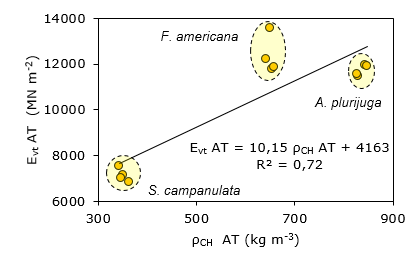
Fig. 4 - Dispersions, correlations and coefficients of determination (R 2 ) between dynamic modules (E vt ) and densities (ρ CH ) before treatment (AT)
Dynamic modules
The average magnitudes of the dynamic modules of S. campanulata, F. americana and A. plurijuga listed in Table 2 were of the same order as those reported by Sotomayor (2019). The average dynamic modules of F. americana were higher than those of S. campanulata and A. plurijuga. Thus, while the arithmetic differences between the values before and after treatment (Table 3) were positive for S. campanulata and A. plurijuga, those corresponding to F. americana decreased. As a result, the average of the differences for all the samples observed was 0.16 %, a calculation difficult to interpret since the effect of the treatment on the dynamic modules reached a maximum value of 8.51 for S. campanulata (C = 1 %) and a minimum value of -11.64 % for F. americana (C = 1 %), that is, an interval of 20.15 %.
The coefficients of variation for the dynamic modules (before and after treatment) averaged 14.1 % (Table 2) and were not affected by the concentrations and/or retention for each sample observed. The dispersions of the dynamic modules are grouped indifferently to the retentions (Figure 3). However, the average values of the four samples corresponding to each species and concentration (Control, C = 1 %, 2 % and 3 %) correlate well with the densities before treatment (Figure 4) and regularly after treatment (Figure 5) .
In the hot-cold bath treatment, the retention values increase proportionally to the concentration of boron salts used, but decrease as the densities of each species increase.
The treatment modifies the dynamic modules determined with transversal vibrations, these differences are of the order of 3,5 % for S. campanulata, of -2,24 % for K and of 0,16 % for A. plurijuga.
The average values of the densities of the three woods, before and after treatment, are good predictors of the dynamic modules.
The hot-cold bath is efficient to impregnate with boron salts woods of S. campanulata, F. americana and A. plurijuga.
Thanks
The research was sponsored by the Universidad Michoacana de San Nicolás de Hidalgo, Mexico.
Referencias bibliográficas
ADANUR, H., FIDAN, M. y YAŞAR, S., 2017. The Technological Properties of Oriental Beech (Fagus orientalis Lipsky) Impregnated with Boron Compounds and Natural Materials. BioResources [en línea], vol. 12, no. 1. DOI 10.15376/biores.12.1.1647-1661. Disponible en: https://www.researchgate.net/publication/316352711_The_Technological_Properties_of_Oriental_Beech_Fagus_orientalis_Lipsky_Impregnated_with_Boron_Compounds_and_Natural_Materials. [ Links ]
ÁVILA, L., HERRERA, M. y RAYA, D., 2012. Preservación de la Madera en México. México: Morelia: Universidad Michoacana de San Nicolás de Hidalgo. ISBN 978-607-00-6102-8. [ Links ]
CRUZ DE LEÓN, J., 2010. Manual para la protección contra el deterioro de la madera [en línea]. México: Guadalajara: Comisión Nacional Forestal. ISBN 83-85192-34-4. Disponible en: https://www.forestalmaderero.com/articulos/item/manual-la-proteccion-deterioro-la-madera.html. [ Links ]
FAYDI, Y., BRANCHERIAU, L., POT, G. y COLLET, R., 2017. Prediction of Oak Wood Mechanical Properties Based on the Statistical Exploitation of Vibrational Response. BioResources, vol. 12, no. 3, pp. 5913-5927. ISSN 1930-2126. Disponible en: https://ojs.cnr.ncsu.edu/index.php/BioRes/article/view/BioRes_12_3_5913_Faydi_Prediction_Oak_Wood_Mechanical_Properties [ Links ]
GÉRARDIN, P. 2016. New alternatives for wood preservation based on thermal and chemical modification of wood- a review. Annals of Forest Science, vol. 73, no. 3, pp. 559-570. ISSN 1297-966X. DOI 10.1007/s13595-015-0531-4. Disponible en: https://link.springer.com/article/10.1007/s13595-015-0531-4 [ Links ]
GUTIÉRREZ PULIDO, H. y DE LA VARA SALAZAR, R., 2012. Análisis y diseño de experimentos [en línea]. S.l.: McGraw-Hill, 2003. [Consulta: 02/03/2020]. ISBN 970-10-4017-1. Disponible en: Disponible en: https://books.google.com/books/about/An%C3%A1lisis_y_dise%C3%B1o_de_experimentos.html?id=1zqtAAAACAAJ . [ Links ]
INTERNATIONAL ORGANIZATION FOR STANDARDIZATION, 2014. Physical and mechanical properties of wood. Test methods for small clear wood specimens. Part 1: Determination of moisture content for physical and mechanical tests. Geneva: International Organization for Standardization, pp. 4. Disponible en: https://www.iso.org/standard/60063.html [ Links ]
INTERNATIONAL ORGANIZATION FOR STANDARDIZATION, GENEVA (SWITZERLAND), 2012. Wood. Sampling methods and general requirements for physical and mechanical testing of small clear wood specimens. ISO International Standard (ISO) [en línea], [Consulta: 02/03/2020]. Disponible en: Disponible en: http://agris.fao.org/agris-search/search.do?recordID=XF2006427072 . [ Links ]
KARTAL, S.N., HWANG, W.-J. y IMAMURA, Y., 2008. Combined effect of boron compounds and heat treatments on wood properties: Chemical and strength properties of wood. Journal of Materials Processing Technology, vol. 198, no. 1, pp. 234-240. ISSN 0924-0136. DOI 10.1016/j.jmatprotec.2007.07.001. Disponible en: https://www.sciencedirect.com/science/article/abs/pii/S0924013607006759 [ Links ]
KESKIN, H. y MUTLU, E., 2017. Impacts of Impregnation with Fire Retardant Chemicals on the MOE in Bending of Some Woods, pages: 607-612. Politeknik Dergisi [en línea], vol. 20, no. 3. DOI 10.2339/politeknik.339384. Disponible en: https://www.semanticscholar.org/paper/Impacts-of-Impregnation-with-Fire-Retardant-on-the-Keskin-Mutlu/9ac439b32362881f24ca84d8ba55e5cd350ee9f6. [ Links ]
LAHTELA, V., HÄMÄLÄINEN, K. y KÄRKI, T., 2013. The Effects of Preservatives on the Properties of Wood after Modification (Review paper). Baltic Forestry, vol. 20, pp. 189-203. Disponible en: https://www.researchgate.net/publication/287560465_The_Effects_of_Preservatives_on_the_Properties_of_Wood_after_Modification_Review_paper [ Links ]
PERÇIN, O., SOFUOGLU, S.D. y UZUN, O., 2015. Effects of Boron Impregnation and Heat Treatment on Some Mechanical Properties of Oak (Quercus petraea Liebl.) Wood. BioResources, vol. 10, no. 3, pp. 3963-3978. ISSN 1930-2126. Disponible en: https://www.researchgate.net/publication/276269687_Effects_of_Boron_Impregnation_and_Heat_Treatment_on_Some_Mechanical_Properties_of_Oak_Quercus_petraea_Liebl_Wood [ Links ]
PIZZI, A., 2016. Wood products and green chemistry. Annals of Forest Science, vol. 73, no. 1, pp. 185-203. ISSN 1297-966X. DOI 10.1007/s13595-014-0448-3. Disponible en: https://link.springer.com/article/10.1007/s13595-014-0448-3 [ Links ]
SILVA GUZMÁN, J.A., FUENTES TALAVERA, F.J., RODRÍGUEZ ANDA, R., TORRES ANDRADE, P.A., LOMELÍ RAMÍREZ, M.A., RAMOS QUIRARTE, J., WAITKUS, C. y RICHTER, H.G., 2010. Fichas de propiedades tecnológicas y uso de maderas nativas de México e importadas [en línea]. 1a edición. S.l.: Guadalajara, Jal. : Universidad de Guadalajara, Departamento de Madera, Celulosa y Papel, Centro de Investigación en Propiedades y usos de la Madera, CONAFOR, Amaya, 2010. [Consulta: 02/03/2020]. ISBN 978-607-00-2894-6. Disponible en: Disponible en: https://glifos.gdl.up.mx/library/index.php?title=53169&lang=%20%20&query=@title=Special:GSMSearchPage@process=@autor=UNIVERSIDAD%20DE%20GUADALAJARA%20(MEXICO) %20@mode=&recnum=9 . [ Links ]
SIMSEK, H. y BAYSAL, E., 2015. Some Physical and Mechanical Properties of Borate-Treated Oriental Beech Wood. Drvna Industrija, vol. 66, pp. 97-103. DOI 10.5552/drind.2015.1356. Disponible en: https://hrcak.srce.hr/140742 [ Links ]
SIMSEK, H., BAYSAL, E. y PEKER, H., 2010. Some mechanical properties and decay resistance of wood impregnated with environmentally-friendly borates. Construction and Building Materials, vol. 24, no. 11, pp. 2279-2284. ISSN 0950-0618. DOI 10.1016/j.conbuildmat.2010.04.028. Disponible en: https://www.sciencedirect.com/science/article/abs/pii/S0950061810001480 [ Links ]
SOTOMAYOR CASTELLANOS, J.R., 2019. Módulos de elasticidad e índices de calidad de maderas mexicanas. Síntesis de datos del Laboratorio de Mecánica de la Madera. Investigación e Ingeniería de la Madera, vol. 15, no. 1, pp. 4-64. [ Links ]
SOTOMAYOR CASTELLANOS, J.R. y AGUILAR, J.M., 2016. Retención de Sales de boro en Tres Maderas Mexicanas. Evaluación Mecánica por Vibraciones. Revista de Ciencia y Tecnología., vol. 18, pp. 40-46. Disponible en: https://www.researchgate.net/publication/317318796_Retencion_de_Sales_de_boro_en_Tres_Maderas_Mexicanas_Evaluacion_Mecanica_por_Vibraciones [ Links ]
SOTOMAYOR CASTELLANOS, J.R. y ÁVILA CALDERÓN, L.E.A., 2019. Retención y penetración de sales de boro en tres maderas angiospermas: Spathodea campanulata, Fraxinus americana y Albizia plurijuga. Ciencia y Tecnología UTEC [en línea], vol. 12, no. 2. ISSN 1390-4043. Disponible en: https://revistas.udistrital.edu.co/index.php/revcie/article/download/9042/11434/. [ Links ]
SOTOMAYOR CASTELLANOS, J.R. y CORREA JURADO, S., 2019. Retention of Salts of Boron on the Wood and its Effect in the Dynamic Modulus of Elasticity. Ciencia y Tecnología UTEC , vol. 12, no. 2, pp. 10. ISSN 1390-4043. Disponible en: https://revistas.udistrital.edu.co/index.php/revcie/article/view/9042 [ Links ]
SOTOMAYOR CASTELLANOS, J.R. y JURADO, S., 2016. Retención de sales de boro en la madera y su efecto en el módulo de elasticidad dinámico. Revista Científica, vol. 1 num 24, pp. 1-19. DOI 10.14483/10.14483/udistrital.jour.RC.2016.24.a9 [ Links ]
SOTOMAYOR, J., FORERO, M. del P.G., SERA, J.G., MÒDOL, E.C. y CASALS, M.V., 2018. Efecto de sales de boro en la densidad y en el módulo de elasticidad de tres maderas mexicanas. Ingeniería: Revista de la Universidad de Costa Rica, vol. 28, no. 2, pp. 31-44. ISSN 1409-2441. Disponible en: https://dialnet.unirioja.es/servlet/articulo?codigo=6493542 [ Links ]
SOTOMAYOR-CASTELLANOS, J.R., VILLASEÑOR AGUILAR, J.M., 2016. Retención y absorción de solución de sales de boro de diez maderas mexicanas. Acta universitaria, vol. 26, no. 2, pp. 12-19. ISSN 0188-6266. DOI 10.15174/au.2016.835. [ Links ]
TAMARIT URIAS, J.C., 2007. Xilotecnología de los principales árboles tropicales de México [en línea]. México: INIFAP. Libro Técnico Núm. 3. Disponible en: https://bibliotecas.uqroo.mx/cgi-bin/koha/opac-detail.pl?biblionumber=33157. QK936 M4 T3. [ Links ]
TONDI, G., WIELAND, S., LEMÉNAGER, N., PETUTSCHNIGG, A., PIZZI, A.P. y THÉVENON, M.F., 2012. Efficacy of tannin in fixing boron in wood. Fungal and Termite resistance. Bioresources, vol. 7, no. 1, pp. 1238-1252. Disponible en: https://www.researchgate.net/publication/257313537_Efficacy_of_tannin_in_fixing_boron_in_wood_Fungal_and_Termite_resistance [ Links ]
Received: December 20, 2019; Accepted: March 20, 2020











 text in
text in 







